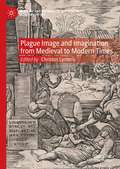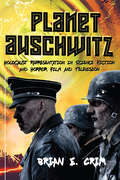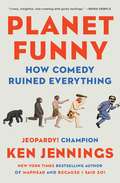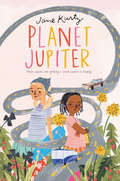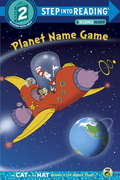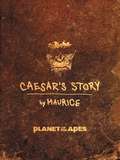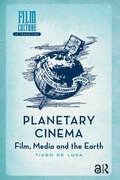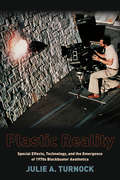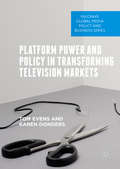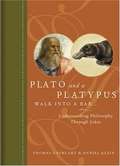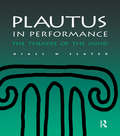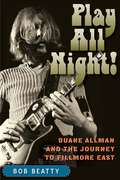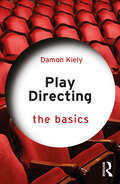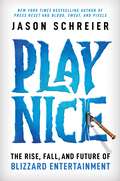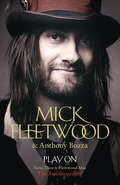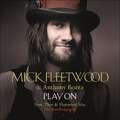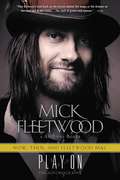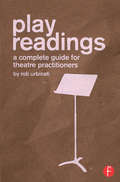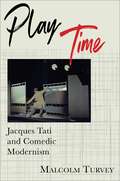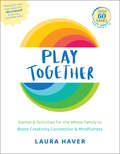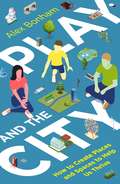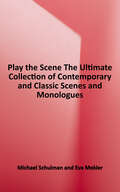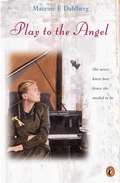- Table View
- List View
Plague Image and Imagination from Medieval to Modern Times (Medicine and Biomedical Sciences in Modern History)
by Christos LynterisThis edited collection brings together new research by world-leading historians and anthropologists to examine the interaction between images of plague in different temporal and spatial contexts, and the imagination of the disease from the Middle Ages to today. The chapters in this book illuminate to what extent the image of plague has not simply reflected, but also impacted the way in which the disease is experienced in different historical periods. The book asks what is the contribution of the entanglement between epidemic image and imagination to the persistence of plague as a category of human suffering across so many centuries, in spite of profound shifts in our medical understanding of the disease. What is it that makes plague such a visually charismatic subject? And why is the medical, religious and lay imagination of plague so consistently determined by the visual register? In answering these questions, this volume takes the study of plague images beyond its usual, art-historical framework, so as to examine them and their relation to the imagination of plague from medical, historical, visual anthropological, and postcolonial perspectives.
Plan It!
by Sharon LucasThe Perfect Planning Guide for Book clubs! The African American author is often overworked, overlooked and underrated. That coupled with the closing of many bookstores, which had long been the gathering place for these authors, and the emergence of E-readers, has changed the way in which our writers and readers meet and converse. Though book clubs have long been a cornerstone of the African American community, at no other time in our history has it been more important for readers to support African American authors and to help fill the void left by the closing of our brick and mortar stores. A well organized book club can be invaluable in spreading the news about great books and talented authors and what better way to achieve that than bringing these two groups together in a well-planned and executed literary event. Plan It! The Complete Resource Guide for Authors, Book Clubs, & Literary Event Planners provides anyone who wants to start a book club with an all-in-one guide to planning book club and literary events. This required companion includes forms, checklists, and tips to start and manage book club meetings, author visits, and planning full-scale literary events. Not just for book clubs, though, this handy guide also provides authors and event planners with the information they need to make any event a resounding success.
Planet Auschwitz: Holocaust Representation in Science Fiction and Horror Film and Television
by Brian E. CrimPlanet Auschwitz explores the diverse ways in which the Holocaust influences and shapes science fiction and horror film and television by focusing on notable contributions from the last fifty years. The supernatural and extraterrestrial are rich and complex spaces with which to examine important Holocaust themes - trauma, guilt, grief, ideological fervor and perversion, industrialized killing, and the dangerous afterlife of Nazism after World War II. Planet Auschwitz explores why the Holocaust continues to set the standard for horror in the modern era and asks if the Holocaust is imaginable here on Earth, at least by those who perpetrated it, why not in a galaxy far, far away? The pervasive use of Holocaust imagery and plotlines in horror and science fiction reflects both our preoccupation with its enduring trauma and our persistent need to “work through” its many legacies. Planet Auschwitz website (https://planetauschwitz.com)
Planet Funny: How Comedy Took Over Our Culture
by Ken JenningsA Kirkus Reviews Best Book of the Year The witty and exuberant New York Times bestselling author and record-setting Jeopardy! champion Ken Jennings relays the history of humor in &“lively, insightful, and crawling with goofy factlings,&” (Maria Semple, author of Where&’d You Go Bernadette)—from fart jokes on clay Sumerian tablets to the latest Twitter gags and Facebook memes.Where once society&’s most coveted trait might have been strength or intelligence or honor, today, in a clear sign of evolution sliding off the trails, it is being funny. Yes, funniness. Consider: Super Bowl commercials don&’t try to sell you anymore; they try to make you laugh. Airline safety tutorials—those terrifying laminated cards about the possibilities of fire, explosion, depressurization, and drowning—have been replaced by joke-filled videos with multimillion-dollar budgets and dance routines. Thanks to social media, we now have a whole Twitterverse of amateur comedians riffing around the world at all hours of the day—and many of them even get popular enough online to go pro and take over TV. In his &“smartly structured, soundly argued, and yes—pretty darn funny&” (Booklist, starred review) Planet Funny, Ken Jennings explores this brave new comedic world and what it means—or doesn&’t—to be funny in it now. Tracing the evolution of humor from the caveman days to the bawdy middle-class antics of Chaucer to Monty Python&’s game-changing silliness to the fast-paced meta-humor of The Simpsons, Jennings explains how we built our humor-saturated modern age, where lots of us get our news from comedy shows and a comic figure can even be elected President of the United States purely on showmanship. &“Fascinating, entertaining and—I&’m being dead serious here—important&” (A.J. Jacobs, author of The Year of Living Biblically), Planet Funny is a full taxonomy of what spawned and defines the modern sense of humor.
Planet Jupiter
by Jane KurtzJupiter is used to being a planet of one, and she likes it that way. But then a cousin, who Jupiter never even knew existed, comes from Ethiopia to stay for the summer, and Jupiter is put in charge of taking care of her. A lyrical and memorable story of family, friendship, and community—perfect for fans of Katherine Hannigan’s Ida B and Holly Goldberg Sloan’s Counting by 7s.Jupiter and her family have spent their lives on the road, moving from town to town in a trusty old van and earning their living by playing music for tourists. But when their van breaks down, Jupiter’s mother rents an actual house in Portland for the summer so Jupiter’s annoying cousin Edom, recently adopted from Ethiopia, can stay with them. Luckily, Edom doesn’t want to be in Portland any more than Jupiter wants her there, and the two hatch a Grand Plan to send Edom back to her mother. In the process, Jupiter learns that community and family aren’t always what you expect them to be.A sweet, genuine story with themes of community, immigration, finances, family, and taking care of the environment that will appeal to fans of Cynthia Lord and Lynda Mullaly Hunt.
Planet Name Game (Step into Reading)
by Tom Brannon Tish RabeA Step 2 Step into Reading Science Reader based on an episode of the hit PBS Kids TV show The Cat in the Hat Knows a Lot About That! Join the Cat in the Hat as he takes Sally and Nick on an adventure into space to learn the names of the eight planets in our solar system! Written in rhyme for children who can read with help, this Step 2 book is a great way to introduce beginning readers to basic concepts about space and to support the Common Core State Standards. Step 2 Readers use basic vocabulary and short sentences to tell simple stories. For children who recognize familiar words and can sound out new words with help.
Planet of the Apes: Caesar's Story
by Greg Keyes MauriceTo celebrate the 50th anniversary of the Planet of the Apes franchise: an illustrated life story of Caesar, the brave and extraordinary leader of the apes, as told by Maurice, Caesar's best friend.After the events of War for the Planet of the Apes, Caesar's tribe has finally found a safe refuge from the last remnants of the humans who wish to see them wiped out. It comes at a cost, however, as Caesar dies before he can see the apes thrive and prosper in their new home. Maurice, as a gift to Caesar's son Cornelius for when he grows older, decides to recount and chronicle Caesar's story so that his son can truly know what a unique and brave ape his father was, and inspire Cornelius in turn.Caesar's Story is this chronicle, and tells the story of Caesar from his earliest days under the care of scientist Will Rodman, as well his life with the ape colony in Muir Woods after the outbreak of the Simian Flu, his interactions with Malcolm and Ellie, the dangerous ape Koba, and his ultimate battle with and imprisonment by the vicious and unstable Colonel. The book also chronicles what happens in-between the events of Rise and Dawn of the Planet of the Apes, as well as the events between Dawn of and War for the Planet of the Apes.The book includes Maurice's personal thoughts and reflections of his long time spent alongside Caesar, and contributions from several other key apes that knew Caesar. The result is a truly one-of-a-kind celebration of the new Planet of the Apes trilogy and the franchise as a whole.TM & © 2018 Twentieth Century Fox Film Corporation. All rights reserved.
Planetary Cinema: Film, Media and the Earth (Film Culture in Transition)
by Tiago LucaThe story is now familiar. In the late 1960s humanity finally saw photographic evidence of the Earth in space for the first time. According to this narrative, the impact of such images in the consolidation of a planetary consciousness is yet to be matched. This book tells a different story. It argues that this narrative has failed to account for the vertiginous global imagination underpinning the media and film culture of the late nineteenth century and beyond. Panoramas, giant globes, world exhibitions, photography and stereography: all promoted and hinged on the idea of a world made whole and newly visible. When it emerged, cinema did not simply contribute to this effervescent globalism so much as become its most significant and enduring manifestation. Planetary Cinema proposes that an exploration of that media culture can help us understand contemporary planetary imaginaries in times of environmental collapse. Engaging with a variety of media, genres and texts, the book sits at the intersection of film/media history and theory/ philosophy, and it claims that we need this combined approach and expansive textual focus in order to understand the way we see the world.
Plastic Reality: Special Effects, Technology, and the Emergence of 1970s Blockbuster Aesthetics (Film and Culture Series)
by Julie TurnockJulie A. Turnock tracks the use and evolution of special effects in 1970s filmmaking, a development as revolutionary to film as the form's transition to sound in the 1920s. Beginning with the classical studio era's early approaches to special effects, she follows the industry's slow build toward the significant advances of the late 1960s and early 1970s, which set the stage for the groundbreaking achievements of 1977. Turnock analyzes the far-reaching impact of the convincing, absorbing, and seemingly unlimited fantasy environments of that year's iconic films, dedicating a major section of her book to the unparalleled innovations of Star Wars and Close Encounters of the Third Kind. She then traces these films' technological, cultural, and aesthetic influence into the 1980s in the deployment of optical special effects as well as the "not-too-realistic" and hyper-realistic techniques of traditional stop motion and Showscan. She concludes with a critique of special effects practices in the 2000s and their implications for the future of filmmaking and the production and experience of other visual media.
Platform Power and Policy in Transforming Television Markets (Palgrave Global Media Policy and Business)
by Karen Donders Tom EvensThis book seeks to investigate ‘platform power’ in the multi-platform era and unravels the evolution of power structures in the TV industry as a result of platformisation. Multiple TV platforms and modes of distribution are competing–not necessarily in a zero-sum game–to control the market. In the volume, the contributors work to extend established ‘platform theory’ to the TV industry, which has become increasingly organised as a platform economy. The book helps to understand how platform power arises in the industry, how it destabilises international relations, and how it is used in the global media value chain. Platform Power and Policy in Transforming Television Markets contributes to the growing field of media industry studies, and draws on scholarly work in communication, political economy and public policy whilst providing a deeper insight into the transformation of the TV industry from an economic, political and consumer level. Avoiding a merely legal analysis from a technology-driven perspective, the book provides a critical analysis of the dominant modes of power within the evolving structures of the global TV value chain.
Plato and a Platypus Walk Into a Bar... Understanding Philosophy Through Jokes
by Thomas Cathcart Daniel KleinFinally a crash course in philosophy via jokes. Gags really do explain the meaning of it all in this lively book, loaded with one-liners, vaudeville humor, cartoons, and even a limerick or two. A hilarious but profound tour de farce through Western philosophy covering such topics as: Logic (Sherlock Holmes never deduced anything!) Existentialism (You haven't lived until you think about death all the time) Ethics (The Sopranos' contribution to the Golden Rule) and Language (It all depends on what your definition of "is" is.)
Plautus in Performance: The Theatre of the Mind (Greek And Roman Theatre Archive Ser. #Vol. 2.)
by Niall W. SlaterPlautus was Ancient Rome's greatest comic playwright, Shakespeare drew heavily on his plots, and his legacy is prevalent throughout modern drama. In this expanded edition of his successful book, one of America's foremost Classical scholars introduces performance criticism to the study of Plautus' ancient drama. In addition to the original detailed studies of six of the dramatists's plays, the methodology of performance criticism, the use of conventions, and the nature of comic heroism in Plautus, this edition includes new studies on: * the induction into the world of the play * the scripted imitation of improvisation * Plautus's comments on his previous work * the nature of 'tragicomedy'.
Play All Night!: Duane Allman and the Journey to Fillmore East
by Bob BeattyThe origin story of a groundbreaking album The 1971 Allman Brothers Band album At Fillmore East was a musical manifesto years in the making. In Play All Night!, Bob Beatty dives deep into the motivations and musical background of band founder Duane Allman to tell the story of what made this album not just a smash hit, but one of the most important live rock albums in history. Featuring insights from bootleg tapes, radio ads, early reviews, never-before-published photos, and the memories of band members, fans, and friends, Beatty chronicles how Allman rejected the traditional route of music business success—hit singles and record sales—and built a band that was at its best jamming live on stage, feeding off the crowd’s energy, and pushing each other to new heights of virtuosic improvisation. Every challenge, from recruiting a group of relatively unknown but established musicians like Jaimoe and Dickey Betts, touring the American South as an interracial band, and the failure of their first two studio albums, sharpened Allman’s determination to pursue the band’s truly unique sound. He made a bold choice—to record their next album live at Bill Graham’s famous concert hall in New York’s Lower East Side, a gamble that launched a new strand of American music to the top of the charts. Four days after the album went gold, Duane Allman was killed in a motorcycle accident. He was 24. This book explores how At Fillmore East cemented Allman’s legacy as a strong-willed, self-taught visionary, giving fans of Southern rock and all readers interested in the role of rock music in American popular culture a new appreciation for this pathbreaking album.
Play Directing: The Basics (The Basics)
by Damon KielyPlay Directing: The Basics introduces theatre students to a step-by-step process for directing plays, including advice on devising. Beginning with a historical overview of directing, this book covers every aspect of the director’s job from first read to closing night. Practical advice on finding plays to produce, analysing scripts, collaborating with the design team, rehearsing with actors, devising company creations, and opening a show are peppered with advice from working professionals and academic directors. A practical workbook, short exercises, helpful websites, and suggested reading encourage readers towards a deeper study of the art of directing. This book empowers high school and early college students interested in theatre and directing to find their own voice, develop a practice, and refine their process.
Play Nice: The Rise, Fall, and Future Of Blizzard Entertainment
by Jason SchreierA NEW YORK TIMES BESTSELLER AND AN NPR BEST BOOK OF 2024 From a New York Times bestselling author and investigative journalist comes The Social Network for the video game industry: a riveting examination of Blizzard Entertainment's rise and shocking downfall—"A fast paced thrill ride, perfect for anyone who has ever played a video game" (Ben Mezrich). For video game fans, the name Blizzard Entertainment was once synonymous with perfection. The renowned company behind classics like Diablo and World of Warcraft was known to celebrate the joy of gaming over all else. What was once two UCLA students' simple mission — to make games they wanted to play — launched an empire with thousands of employees, millions of fans, and billions of dollars. But when Blizzard cancelled a buzzy project in 2013, it gave Bobby Kotick, the infamous CEO of corporate parent Activision, the excuse he needed to start cracking down on Blizzard's proud autonomy. Activision began invading Blizzard from the inside. Glitchy products, PR disasters, mass layoffs, and a staggering lawsuit marred the company's reputation and led to its ultimate reckoning. Based on firsthand interviews with more than 300 current and former employees, Play Nice chronicles the creativity, frustration, beauty, and betrayal across the epic 33-year saga of Blizzard Entertainment, showing us what it really means to "bleed Blizzard blue." Full of colorful personalities and dramatic twists, this is the story of what happens when the ruthless pursuit of profit meets artistic idealism.
Play On: Now, Then and Fleetwood Mac
by Mick Fleetwood"After forty-six years of being on the road, now is the right time to look back in a way I've never done before: now and then. I'm looking forward to sharing it with you." Mick Fleetwood has been part of one of the world's most successful and adored bands for over four decades. Here he tells the full and candid story of that life, and what it is to be part of the ever evolving Fleetwood Mac. His all-access autobiography spans the career of one of classic rock's greatest drummers and band leaders, the co-founder of the deeply loved super group that bears his name. In this intimate portrait of a life lived in music, Fleetwood vividly recalls his upbringing in Cornwall, Egypt and Norway tapping along to whatever song was playing on the radio; his experiences as a musician in Sixties London; the early days of the band featuring Peter Green, and his close friendship with George Harrison and seemingly all of music royalty. Play On sheds new light on Fleetwood Mac's raucous history describing the highs and lows of being part of a band that he often single-handedly kept together. His love affair with Stevie Nicks, the creation of landmark albums like Rumours and Tusk, and the many incredible and outrageous moments of recording, touring, fighting, and loving with Fleetwood Mac: all are here. He describes his life's moments with the honesty and immediacy that his fans expect, taking us to the very heart of this multi layered life. It's been a tumultuous journey with the excesses of the band's huge success at times threatening to destroy what they strived so hard to create. But through it all it's been the drive to play on that has won out. Now, then, and always, it's Fleetwood Mac.
Play On: Now, Then and Fleetwood Mac
by Mick Fleetwood"After forty-six years of being on the road, now is the right time to look back in a way I've never done before: now and then. I'm looking forward to sharing it with you." Mick Fleetwood has been part of one of the world's most successful and adored bands for over four decades. Here he tells the full and candid story of that life, and what it is to be part of the ever evolving Fleetwood Mac. His all-access autobiography spans the career of one of classic rock's greatest drummers and band leaders, the co-founder of the deeply loved super group that bears his name. In this intimate portrait of a life lived in music, Fleetwood vividly recalls his upbringing in Cornwall, Egypt and Norway tapping along to whatever song was playing on the radio; his experiences as a musician in Sixties London; the early days of the band featuring Peter Green, and his close friendship with George Harrison and seemingly all of music royalty. Play On sheds new light on Fleetwood Mac's raucous history describing the highs and lows of being part of a band that he often single-handedly kept together. His love affair with Stevie Nicks, the creation of landmark albums like Rumours and Tusk, and the many incredible and outrageous moments of recording, touring, fighting, and loving with Fleetwood Mac: all are here. He describes his life's moments with the honesty and immediacy that his fans expect, taking us to the very heart of this multi layered life. It's been a tumultuous journey with the excesses of the band's huge success at times threatening to destroy what they strived so hard to create. But through it all it's been the drive to play on that has won out. Now, then, and always, it's Fleetwood Mac.(P)2014 Hodder & Stoughton
Play On: Now, Then, and Fleetwood Mac: The Autobiography
by Mick Fleetwood Anthony BozzaMick Fleetwood, the drummer and cofounder of the mega-selling band Fleetwood Mac, tells all.In this candid, intimate portrait of a life lived in music, Mick Fleetwood sheds new light on well-known points in his history, including many incredible moments of recording and touring with Fleetwood Mac, as well as personal insights from a man who has been a major player in blues and rock n' roll since his teens.The group Fleetwood Mac has sold over 140 million records worldwide, and they continue to attract a huge following, selling out their biggest arena tour ever in 2013, decades after their debut. Finally, the group's admirers will have a unique portrait of what made Mick and the rest of the group tick in the midst of their massive success and personal trials.
Play Readings: A Complete Guide for Theatre Practitioners
by Rob UrbinatiPlay Readings: A Complete Guide for Theatre Practitioners demystifies the standards and protocols of a play reading, demonstrating how to create effective and evocative readings for those new to or inexperienced with the genre. It examines all of the essential considerations involved in readings, including the use of the venue, pre-reading preparations, playwright/director communication, editing/adapting stage directions, casting, using the limited rehearsal time effectively, simple "staging" suggestions, working with actors, handling complex stage directions, talkbacks, and limiting the use of props, costumes, and music. A variety of readings are covered, including readings of musicals, operas, and period plays, for comprehensive coverage of this increasingly prevalent production form.
Play Time: Jacques Tati and Comedic Modernism (Film and Culture Series)
by Malcolm TurveyJacques Tati is widely regarded as one of the greatest postwar European filmmakers. He made innovative and challenging comedies while achieving international box office success and attaining a devoted following. In Play Time, Malcolm Turvey examines Tati’s unique comedic style and evaluates its significance for the history of film and modernism.Turvey argues that Tati captured elite and general audiences alike by combining a modernist aesthetic with slapstick routines, gag structures, and other established traditions of mainstream film comedy. Considering films such as Monsieur Hulot’s Holiday (1953), Mon Oncle (1958), Play Time (1967), and Trafic (1971), Turvey shows how Tati drew on the rich legacy of comic silent film while modernizing its conventions in order to encourage his viewers to adopt a playful attitude toward the modern world. Turvey also analyzes Tati’s sardonic view of the bourgeoisie and his complex and multifaceted satire of modern life. Tati's singular and enduring achievement, Turvey concludes, was to translate the democratic ideals of the postwar avant-garde into mainstream film comedy, crafting a genuinely popular modernism. Richly illustrated with images from the director’s films, Play Time offers an illuminating and original understanding of Tati’s work.
Play Together: Games & Activities for the Whole Family to Boost Creativity, Connection & Mindfulness
by Laura HaverRediscover play with over 60 screen-free family activities and games that promote bonding, connection, and growth.Featuring over 60 games, Play Together is your go-to guide for family fun. Based on happiness, play, communication, and emotional intelligence research, the games and activities are more than just enjoyable. They also teach important life skills and catapult your family&’s development in the following:ConnectionCreativityMindfulnessKindnessMovement and morePlus, they&’re simple. You can play most games in five minutes using materials you already have on hand. Activities are categorized by type (see above) and include detailed instructions as well as tips, anecdotes and conversation prompts for families. Some of the games included are:Marble Mania Madness 3-2-1…Freeze! The What If? Imagination Game Cardboard Creations Snap-A-Letter Scavenger Hunt Make Your Own Puzzle DJ Art Floor Pong and more!Ever wish life (and parenting) was more fun? Stop wondering what to do with your kids and instead begin to play together. You&’ll be amazed at the wonder these games open up in you and your family&’s lives. Optimized for kids 12 and under and fun for people of all ages!
Play and the City: How to Create Places and Spaces To Help Us Thrive
by Alex BonhamPlay is essential, for children but also adults. It's how we relax and revitalise ourselves, build and maintain friendships, try new things, learn and innovate.Cities have always been sites of play, bringing people together and pushing the boundaries of what is humanly possible. And now we need our cities to encourage and facilitate play of all kinds more than ever. If we want a world for our children to play in, we need to have a go at doing things differently. A city that is enjoyable to live in - that provides welcoming spaces, plentiful resources, and an attitude of 'yes, you can' - is a playful city. A city that is good for eight-year-olds as well as eighty-year-olds is a city that's good for all of us. By looking at how different cities across space and time have sought to encourage and facilitate play, Bonham shows us how to conceptualise our own contemporary city as a game, and encourages us to become participants rather than spectators.Play the city! Get involved, make a difference and help to bring your city back to life. There is help here to identify opportunities, build a team of friends and allies, take part - and win! It's time to make your move.
Play and the City: How to Create Places and Spaces To Help Us Thrive
by Alex BonhamPlay is essential, for children but also adults. It's how we relax and revitalise ourselves, build and maintain friendships, try new things, learn and innovate.Cities have always been sites of play, bringing people together and pushing the boundaries of what is humanly possible. And now we need our cities to encourage and facilitate play of all kinds more than ever. If we want a world for our children to play in, we need to have a go at doing things differently. A city that is enjoyable to live in - that provides welcoming spaces, plentiful resources, and an attitude of 'yes, you can' - is a playful city. A city that is good for eight-year-olds as well as eighty-year-olds is a city that's good for all of us. By looking at how different cities across space and time have sought to encourage and facilitate play, Bonham shows us how to conceptualise our own contemporary city as a game, and encourages us to become participants rather than spectators.Play the city! Get involved, make a difference and help to bring your city back to life. There is help here to identify opportunities, build a team of friends and allies, take part - and win! It's time to make your move.
Play the Scene: The Ultimate Collection of Contemporary and Classic Scenes and Monologues
by Michael Schulman Eva MeklerAlexander Dumas - Christopher Durang - Beth Henley - Kenneth Lonergan - Donald Margulies - Steve Martin - Nicky Silver - Bernard Shaw - Alfred Uhry - Paula Vogel A collection of the greatest scenes and monologues ever written ranging from Elizabethan to Tony Award-winning plays comprehensive anthology spans over five hundred years of theatre. Play the Scene: The Ultimate Collection of Contemporary and Classic Scenes and Monologues by coauthors Michael Schulman and Eva Mekler includes scenes and monologues from classic plays by such notable authors as Edith Wharton as well as the best in contemporary theatre, such as Margaret Edson's Wit. - Blight Spirit - Camille - The Chosen - The Graduate - How I Learned to Drive - The Last Night of Ballyhoo - The Lisbon Traviata - This Is Our Youth - Vincent in Brixton - And many more!
Play to the Angel
by Maurine F. DahlbergAustria in 1938 is under the shadow of the Nazis, but 12-year-old Greta doesn't notice--she cares only for her piano lessons with their new neighbor. Then the Nazis invade and Greta discovers her teacher's secret. His life is in danger, and she may be the only one who can help him.
